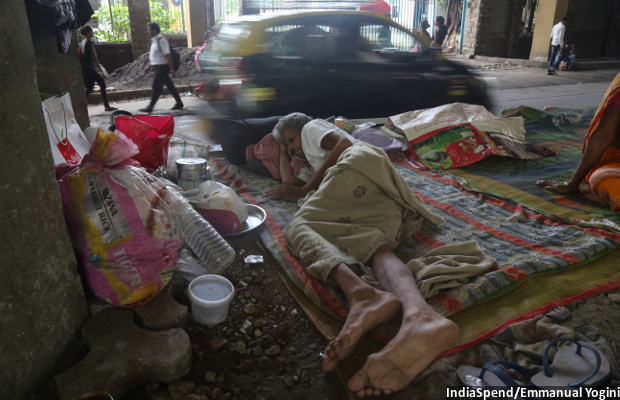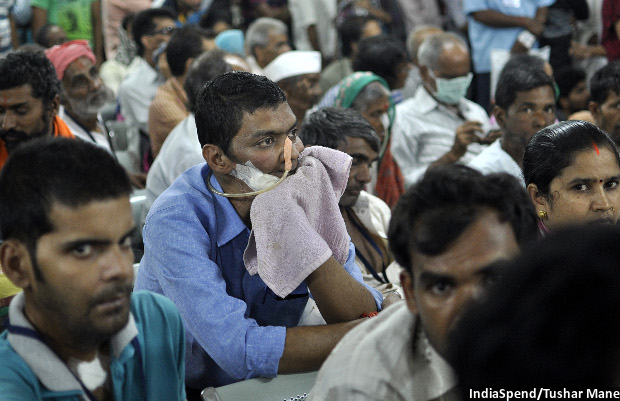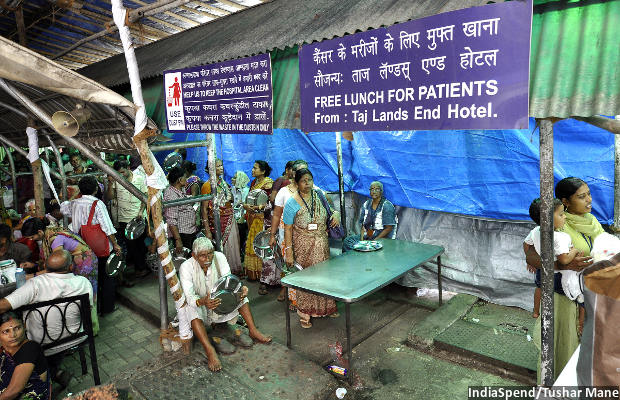On A Mumbai Street, Aspiring Soldier Endures India’s Cancer-Care Crisis
A cancer patient resting on the divider under the monorail station near Tata Memorial Hospital, Parel, Mumbai. Many cancer patients--unable to afford a hotel or a dharmshala (rest house)--stay on the pavements around the hospital till their treatment is complete.
Mumbai: For the past four months--as his life turned from college student in Bihar to cancer patient on a Mumbai footpath--Arvind Kumar, 24, has been bothered by one question: How did I get oral cancer?
Kumar never smoked, chewed gutkha, paan (betel leaf) or tambaku (tobacco), the source of cancers in four of ten Indians so afflicted. His right eye eaten away by cells growing out of control, Kumar found it difficult to speak. So his brother-in-law explained how the Bachelor of Arts student from Bettiah district in western Bihar--and, as his family’s most educated member, their great hope--came to be here, after visiting seven doctors in five cities over five months, more than 1,866 km from home.
Sitting on a thin, plastic mat, Kumar--who is checked bi-weekly and gets chemotherapy and radiation once in three weeks--is one of about 50 patients who, on any given day, are spread across the footpath of Jerbai Wadia road at the front and rear of Tata Memorial Hospital’s Homi Bhabha Wing in central Mumbai. Either sitting or lying down on thin mats, they are usually accompanied by family members. Their medical files and medicines are placed in plastic bags hanging on a wall. A bag full of clothes is usually next to them. Some have a thin tarpaulin for a roof and a stove.
Run by the Department of Atomic Energy, the 76-year-old Tata Memorial Hospital--India’s leading tertiary referral centre--is ground zero of India’s unfolding cancer-care crisis. Although India’s incidence of cancer is still low compared to the West, it is spreading, and the lack of quality cancer care sets people like Kumar on trans-subcontinental journeys that end on the pavement of Jerbai Wadia road.
That is why this IndiaSpend’s three-part special report on cancer treatment is focussed on the Tata Memorial Hospital. In part one, we describe Kumar’s journey to Mumbai and the trauma his family endures. In part two, we calculate the economic and social cost of cancer through a survey of cancer patients living on Jerbai Wadia street’s pavements. In the third part, we investigate the government’s programmes for cancer care for its poorest patients.
Cancer is now known to strike at any age, as cells grow out of control due to multiple reasons: A flaw in your genes, toxins in the air and in your food, or consumption of tobacco or excess alcohol. Cancer’s changing characteristics are made worse by India’s inability to even gauge the disease’s spreading tentacles.
There were 1.45 million new cases of cancer and 736,000 deaths in India in 2016, expected to increase to 1.73 million in 2030, with 880,000 deaths by 2020.
India’s (man-made) cancer-care crisis
A million Indians are diagnosed with cancer every year, and 680,000 die from a disease once regarded as an affliction of the western world. India’s cancer burden is now expected to rise 70% over the next 18 years, from nearly 1 million new cases in 2012 to 1.7 million by 2035 according to GLOBOCAN, an international initiative on cancer data.
These may be underestimations because there were 1.45 million new cases of cancer and 736,000 deaths in India in 2016, expected to increase to 1.73 million in 2030, with 880,000 deaths by 2020, according to data from the National Cancer Registry Programme of the Indian Council of Medical Research.
The most common cancers in Indian men are oral and of the esophagus, stomach and lung; in women oral and of the cervix, breast and esophagus.
Although the incidence of cancer in India is half the world average--94 per 100,000 compared to 182 per 100,000--and a third of the incidence in developed countries (268 per 100,000), cancer care is scarce.
India has no more than 250 dedicated cancer-care centres (0.2 per million population in India vs 4.4 per million population in the US), 40% of which are present in eight metropolitan cities and fewer than 15% are government-operated, noted a 2015 study, Call for Action: Expanding Cancer Care in India, by Ernst and Young, a consultancy.
That is why 80% of India’s cancer cases come to medical attention at an advanced stage, one reason why 68% of patients with cancer die of the disease in India, compared to 33% in the US. India also has 0.98 oncologists per million population, compared to 15.39 in China, 25.63 in Philippines and 1.14 in Iran.
So, many cancer patients must travel great distances to only 27 government cancer referral centres and 250 cancer centres nationwide. That explains the patients on the footpaths outside Tata Memorial Hospital and India’s high mortality and morbidity from and expenditure on cancer.
“The reason patients come to Tata Memorial Hospital are two-- first is (because of) the 76-year-old brand value and trust among the public, and second, thanks due to generous funding from government of India, we have a decent price structure, where for the same service, patients in private wards pay 10 times more,” said Anil D’Cruz, director of the Tata Memorial Hospital.
Government spending on cancer in India 1/10th average of high income countries
Public expenditure on cancer in India remains below US $10 per person, compared with more than US $100 per person in high income countries.
Furthermore, the care provided at many cancer centres in India is often dictated by facilities available. For example, many centres nationwide do not have access to radiotherapy. On average, there are 2–5 million people per radiotherapy machine, ten times more than the 250,000 people per machine in high-income countries.
Source: Cancer Atlas, 2012
Cancer in India differs from western countries because many cancer cases in India are associated with tobacco use (40%), infections (20%), and other avoidable causes. “Social factors, especially inequalities, are major determinants of India's cancer burden, with poorer people more likely to die from cancer before the age of 70 years than those who are more affluent,” said a 2014 paper in Lancet Oncology, a global medical journal.
Kumar’s story reflects the characteristics of India’s cancer-care crisis, as identified by researchers and medical professionals.
A toothache leads to six doctors, five cities and a 5,500-km journey
When we first met him in May 2017, Kumar was dressed in a loose, white shirt and loose black pants, much like the thousands who migrate to India’s richest city from small towns. The handkerchief tied on his head, covering his right eye, gave away his cancer. He opened it to show us how a tumour had taken over his eye, the area from head to eye socket swollen.
It began five months ago in March 2017, with a pain in Kumar’s teeth. As the pain grew, a swelling began in his mouth and within 45 days had spread to his right eye.
These niggles came at a time when Kumar had been watching his diet, jogging every morning and working on his physique to realise his ambition--to enlist in the Indian army.
His family took him to Patna Government Hospital, 200 km to the south, where the doctors told him that a surgery was needed. It would cost Rs 250,000. The family then travelled 260 km north to Gorakhpur where a biopsy revealed cancer. They consulted six doctors, travelling over three months and about 1,000 km, from Gorakhpur in Uttar Pradesh to Motihari in Bihar to Varanasi in Uttar Pradesh, and spent Rs 100,000.
Kumar did not get better.
Then, someone from Kumar’s village told him to go to Mumbai for medical care. Three of the family—Arvind Kumar, his brother-in-law Chand Singh Mahto, 30, and his mother, Nirmala Devi, 55, made the journey to Mumbai in April 2017.
A cancer patient resting on the divider under the monorail station near Tata Memorial Hospital, Parel, Mumbai. Many cancer patients--unable to afford a hotel or a dharmshala (rest house)--stay on the pavements around the hospital till their treatment is complete.
In seeking cancer care, savings exhausted, Rs 50,000 loan from relatives
Kumar’s dream of becoming a soldier has been swept aside by a string of concerns: Will he live? Will he look normal again? When will the doctors allow him to go home? Will he be able to help his family pay back the loans they have taken?
Kumar’s family borrowed Rs 50,000 from their relatives, after exhausting their own savings.
Once in Mumbai, when Kumar and his family found hotels and guest houses charging anything from Rs 600 to Rs 2,000 per day, they saw other patients living on the footpath and joined them.
When IndiaSpend met them, the family had spent Rs 60,000 on treatment over two months in Mumbai. While consultation is highly subsidised, patients above the poverty line must pay for tests and medicine at Tata Memorial Hospital (free for those certified as poor). The family’s daily expenses range from Rs 200 to Rs 300 in Mumbai. Their finances have been hit hard by Kumar’s cancer. Aside from losing their savings and the pending loans, they have lost the income they might have earned during this time.
Mahto, a labourer, gave up work to be with Kumar. His wife, Kumar’s sister, is at home, taking care of their two daughters, brother and father. Kumar’s father, an agricultural worker, is the sole earning member. Kumar’s younger brother is a Class X student.
Arvind Kumar--now too weak to stand or walk--is undergoing free chemotherapy and has moved to the nearby Nana Palkar dharmshala, where he will get free food and accommodation--for a month.
Lining up at 4 am to see the doctor at 2 pm
Since he came to Mumbai, Kumar received swift treatment. Tuesdays and Wednesdays are for out-patients at the head and neck cancer department, and even though consultation begins at 8 am, the line to enter the hospital begins to form four hours earlier, at 4 am. The gates open at 7 am.
“If you line up early in the morning, the doctor sees you at 2 pm,” said Mahto, Kumar’s brother in law. Inside the hospital, the patients get free snacks and meals during out-patient department (OPD) hours, attendants must pay between Rs 50 and Rs 100 for each meal.
Kumar suffers from the side-effects of the chemotherapy and radiation that he receives every three weeks.
“I feel very nauseous and I throw up everything I eat,” he said. The skin of his forearms had gone dark because the radiotherapy which is supposed to kill cancer cells by high energy radiation also affects normal cells.
Life on the street: Nights are the worst
Life on the footpath isn’t easy. Patients spend Rs 5 to use the toilet and Rs 20 to bathe in a public restroom. Drinking water must be filled from a hospital canteen.
“The worst of the ordeal is every night,” said Nirmala Devi, Arvind’s mother, referring to the policemen who rouse and drive away patients and their families, who gather their reports, medicines, clothes and other belongings and find shelter alongside the awnings of closed shops.
Why don’t they move to a dharmshala (non-religious rest house)? “I have been to Nana Palkar (a dharmshala run by a private trust) four times,” said Mahto. “They say bring a letter from social worker; the social worker says we do not fit the criteria (They are not poor enough). We don’t want to live on the footpath, but we can’t find accommodation anywhere.”
Although Kumar’s father is a labourer, he is officially above the poverty line--he has an above poverty line (APL) ration card and, so, cannot get what is called an NC, or no-charges approval, which allows minimal charges for some hospital services and no charge for investigations or consultation.
When IndiaSpend met them again in early June 2017, the family was worried about the monsoons. “We found shelter in the monorail station nearby last night when it rained,” Mahto said as the rain bucketed down.
Every day Taj Hospitality, a part of the Taj Hotels group, provides free lunch to about 300 patients in Tata Memorial Hospital, Parel.
Why patients return to the footpath
While the Tata Memorial Hospital’s social service provides needy children with free cancer treatment and accommodation, their families are also, sometimes, given skill training and a living space at St Jude’s, an NGO. But adults with cancer have fewer options. The hospital makes periodic attempts to move them off the street.
“We had moved all the patients (living on the footpath) and given them free accommodation in 165 rooms at Bombay Port Trust quarters, but they all came back,” said S H Jafri, Public Relations Officer (PRO), Tata Memorial Hospital. “There are enough NGOs to accommodate all cancer patients at affordable rates, but those who stay on the footpath do not want to move due to free food distributed here.”
Every day Taj Hospitality, a part of the Taj Hotels group, provides free lunch to about 300 patients in Tata Memorial Hospital; they also get breakfast at 6 am. Other non-profits and trusts also provide food and other essentials from time to time.
“This may be true for the patients who stay on the other side of the hospital,” said Mahto, reacting to the PRO’s comment. “They have been treated years ago but still stay there.”
Interviews with other cancer patients on the footpath revealed that while some patients do not relocate to other affordable options out of choice--living outside the hospital is convenient and gets them to the 4 am line quicker--many said they did not know about other accommodation facilities. Some said they tried and returned to the footpath.
As you read this story, Arvind Kumar--now too weak to stand or walk--is undergoing free chemotherapy and, after staying under a monorail station for two months, has moved to the nearby Nana Palkar dharmshala, where he will get free food and accommodation--for a month.
(This is the first of a three-part series. You can read the second part here and third part here.)
Next: Bankrupt, Poorly Educated, Desperate: Cancer Patients On Mumbai Footpath
(Yadavar is a principal correspondent at IndiaSpend.)
We welcome feedback. Please write to respond@indiaspend.org. We reserve the right to edit responses for language and grammar.
__________________________________________________________________
“Liked this story? Indiaspend.org is a non-profit, and we depend on readers like you to drive our public-interest journalism efforts. Donate Rs 500; Rs 1,000, Rs 2,000.”







